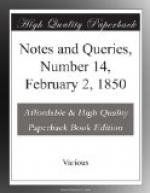J.I.
Dick Shore.—Your correspondent, J.T. HAMMACK, is not quite correct in stating, No. 9., p. 141., that the modern maps present no trace of the locality of “Dick Shoare,” mentioned in the Pepysian Diary. In one of Smith’s maps, now before me, of the date of 1806, I find “Duke Shore Stairs,” not far from the great turn of the river southward, opposite to the Isle of Dogs. Whether the proper spelling to be Dick, Dyke, Dock, Dog, or Duke, I leave to your readers to determine; but I presume there can be no doubt as to the identity of the place. As the origin of the name of “Isle of Doggs,” according to the Pepysian orthography, is said to be still underdetermined; may it not be connected with the modern term DOCKS? We are daily familiarised to worse corruptions. Docks are excavations, large or small, formed by the operation of digging, in Dutch called Doken.
J.I.
[DICK’S SHORE, Fore
Street, Limehouse, and DICK’S SHORE
ALLEY, by Dick’s
Shore, are both mentioned in London and its
Environs, vol. ii. p.
233.]
Travelling in England.—Mr. Steven’s quotation (No. 11., p. 167.) of Bernard Calvert’s rapid journey, as from an anonymous History of England written in the early part of the reign of George I., is to be found in more detail in Stow (1032.), and is transcribed in Mr. Croker’s Notes on Bassompiere’s Embassy, 1819.
Sanuto.—The Ragguagli sulla Vita e sulle Opere di Maria Sanuto, referred to in No. 5., p. 75., were edited by Mr. Rawdon Browne, an English gentleman long resident at Venice, and a most accomplished Italian scholar. The Diary of Sanuto could hardly be printed, filling, as it does, some twenty or thirty thick large folio volumes.
R.M.M.
Darnley’s Birth-place.—In answer to the inquiry in No. 8., p. 123., as to the birth-place of Henry Lord Darnley, I believe he was born at Temple-Newsom, near Leeds, the seat of the Lords Irvine, and now of Meynell Ingram, Esq. A noble room is there shown as the traditional scene of his birth.
R.M.M.
History of Edward II.—The compilers of the British Museum Catalogue attribute the History of Edward II. (referred to in No. 4., p. 59.) to Edward Fannant, who also published a Narration of the Memorable Parliament of 1386, which has been several times printed.
J.R.S.
Lord Chatham’s Speech on the American Stamp Act.—When I read the question of your correspondent {221} (in No. 1. p. 12.) on this subject, I saw at once its importance; for, if my Lord Brougham’s statements were correct, our historians must forthwith re-write a somewhat important chapter in our history. I felt assured, however, that it was not correct; and the result of a somewhat tedious search is as I had anticipated. His lordship had made an error in a date and 1764 should be 1766. The authority, not acknowledged by his lordship, was, no doubt, the Parliamentary History of 1766 (vol. xvi. p. 96.), where your correspondent will find the statement, which of course, the date being correctly given, contains nothing that is not consistent with known facts.




